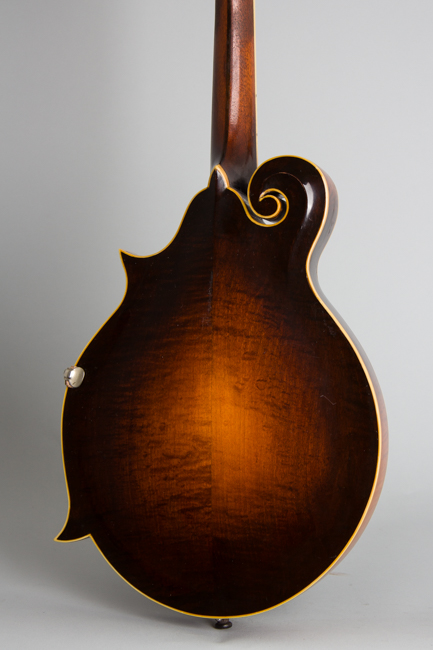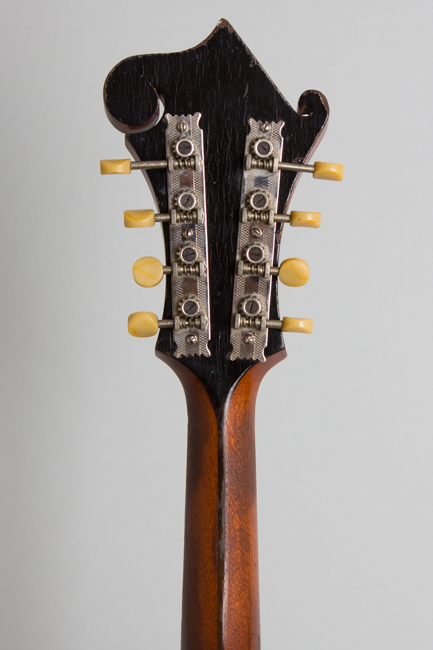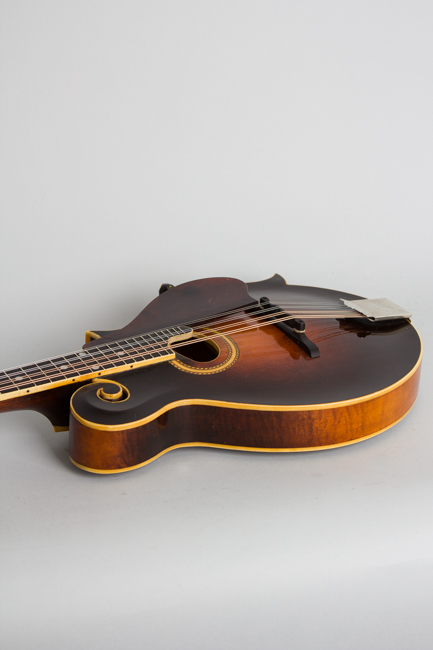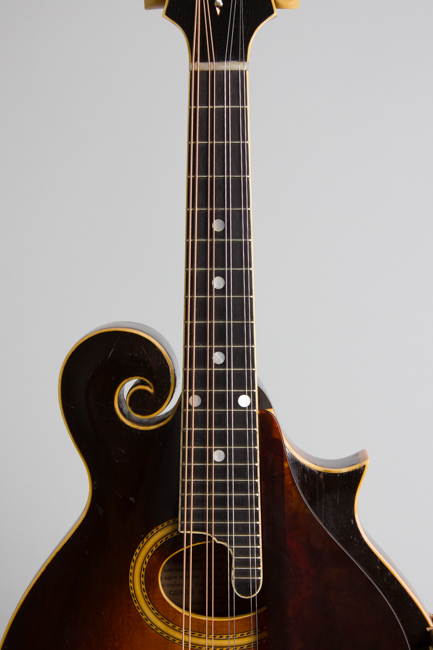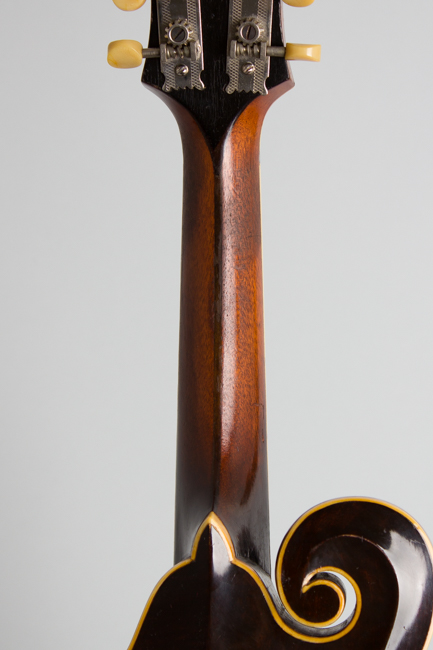Gibson F-4 Arch Top Mandolin (1922)
This item has been sold.
Item # 10973
Prices subject to change without notice.
Gibson F-4 Model Arch Top Mandolin (1922), made in Kalamazoo, Michigan, serial # 69416, Cremona Brown Sunburst varnish finish, Maple back and sides, spruce top, mahogany neck with ebony fingerboard, yellow road case.
As vintage mandolins go there are not too many more hallowed instruments than a Gibson Style F-4 Artist Model from the early 1920's. This example was built around the beginning of 1922, just as the "Lloyd Loar" period was getting seriously underway at the Kalamazoo factory. It carries a very early example of the darker, more ambered (and less red) sunburst finish Gibson would shortly begin calling "Cremona Brown" and using on the new Style 5 Master Models. At the time this mandolin was made the F-5 was in the design process but not yet in production; this F-4 was still Gibson's top-of-the-line mandolin. As such it represents a lovely portrait of Gibson's craftsmanship approaching the apex of the mandolin era, before the company's focus shifted to banjos and then guitars.
Both the serial number on the label and the Factory order number stamped on the neck block of this mandolin remain clear and date to the early months of 1922, just before the F-5 was to be launched. Mandolins from this particular time are revered for their beautiful sound, elegant Art Nouveau look and exceptional build quality, the result of 20 years of Gibson perfecting founder Orville's designs. Even after the $250 F-5's introduction the F-4 remained priced at $150.00, an extremely expensive and prestigious instrument.
This F-4 still has a mix of features typical of the period. The two-piece back and sides are made of superbly grained flamed maple; despite Gibson's catalog descriptions, only the Style 4 instruments were actually built with the specified maple body. The top, back and sides feature a beautiful deep sunburst finish, shaded from deep brown to an amber center without the red pigment used earlier. Loar chose this as the trademark look for his Master Models, with "Cremona Brown" referencing the birthplace of the most revered violins in the world. Relatively few F-4's were finished this way, making this one something of a rarity.
The top, back and neck are bound in grained ivoroid. The soundhole has a wide ivoroid band with half-herringbone trim lines around it. Other fittings are standard for the period including a raised tortoise celluloid pickguard with the side clamp, engraved "The Gibson" tailpiece cover and ivoried button tuners. The adjustable ebony bridge on this instrument is period styled but a more recent piece.
The elaborate scrolled headstock is bound and carries the slanted "The Gibson" pearl logo over the original long "flowerpot" inlay that would be discontinued within a year or so due to the addition of a truss rod cover. The mahogany neck pre-dates the introduction of the adjustable truss rod; it has an ebony strip down the center and is slightly slimmer than 1910's examples with a more subtle but still distinct "V" profile. The tuners are the special open back strips specific to this model, with elongated shafts on the ends. A distinctive touch from this period is a genuine pearl nut.
The venerable F-4 was overshadowed by the new heavily-promoted F-5 after 1923, but examples from the first half of the decade are among the finest ever built and spectacular sounding mandolins. The tone is mellower than Gibson's subsequent F-hole instruments, but with plenty of body and "bite" when needed. This instrument would have been the top choice for any virtuoso mandolinist in 1922, and today is still an iconic creation, especially in this fairly rare and very attractive finish. It has some scars from just about a century of use but like a fine old violin is still a wonderful instrument to play.
Overall length is 26 1/4 in. (66.7 cm.), 10 in. (25.4 cm.) wide at lower bout, and 1 3/4 in. (4.4 cm.) in depth, measured at side of rim. Scale length is 14 in. (356 mm.). Width of nut is 1 3/16 in. (30 mm.).
This mandolin shows general wear overall but has remained intact and largely original over the last 99 or so years. The finish shows dings, scratches and dents most notably to the top but retains excellent color with minimal fade and a lovely patina. There is a noticeable mark in the finish from long mis-location of the bridge; this is unfortunately common with older Gibson mandolins. There is a long scratch off the lower body point that looks like a crack but is not. The back of the neck is partially worn down to the wood, while the headstock has checking and dinging on the face and some wear spots to the back edges.
The only visible repair is a tight spruce grain crack to the top running back from the front edge, forward of the pickguard below the fingerboard. This is relatively inconspicuous and has been sealed with some finish polish-out and touch-up added. The instrument shows no other cracks or repairs, a couple of the back/side seams have the slightest hint of unevenness but all are solid. The headstock scroll has never suffered any splits, which is common with these. Nearly all the hardware is original and complete including the tuners, tailpiece, and raised celluloid pickguard; only the adjustable ebony bridge is a modern repro of the correct Loar-era piece.
The frets appear to be the original thin wire, crowned down slightly and showing very little wear. This is a very sweet and enjoyable mandolin to play with a sparkling sound and comfortable action. With its stately Cremona finish it is beautiful to behold and an especially classy survivor of the eventful century since Gibson's first glory days. It is housed in a modern fiberglass case that is functional but slightly oversize. Overall Excellent - Condition.
As vintage mandolins go there are not too many more hallowed instruments than a Gibson Style F-4 Artist Model from the early 1920's. This example was built around the beginning of 1922, just as the "Lloyd Loar" period was getting seriously underway at the Kalamazoo factory. It carries a very early example of the darker, more ambered (and less red) sunburst finish Gibson would shortly begin calling "Cremona Brown" and using on the new Style 5 Master Models. At the time this mandolin was made the F-5 was in the design process but not yet in production; this F-4 was still Gibson's top-of-the-line mandolin. As such it represents a lovely portrait of Gibson's craftsmanship approaching the apex of the mandolin era, before the company's focus shifted to banjos and then guitars.
Both the serial number on the label and the Factory order number stamped on the neck block of this mandolin remain clear and date to the early months of 1922, just before the F-5 was to be launched. Mandolins from this particular time are revered for their beautiful sound, elegant Art Nouveau look and exceptional build quality, the result of 20 years of Gibson perfecting founder Orville's designs. Even after the $250 F-5's introduction the F-4 remained priced at $150.00, an extremely expensive and prestigious instrument.
This F-4 still has a mix of features typical of the period. The two-piece back and sides are made of superbly grained flamed maple; despite Gibson's catalog descriptions, only the Style 4 instruments were actually built with the specified maple body. The top, back and sides feature a beautiful deep sunburst finish, shaded from deep brown to an amber center without the red pigment used earlier. Loar chose this as the trademark look for his Master Models, with "Cremona Brown" referencing the birthplace of the most revered violins in the world. Relatively few F-4's were finished this way, making this one something of a rarity.
The top, back and neck are bound in grained ivoroid. The soundhole has a wide ivoroid band with half-herringbone trim lines around it. Other fittings are standard for the period including a raised tortoise celluloid pickguard with the side clamp, engraved "The Gibson" tailpiece cover and ivoried button tuners. The adjustable ebony bridge on this instrument is period styled but a more recent piece.
The elaborate scrolled headstock is bound and carries the slanted "The Gibson" pearl logo over the original long "flowerpot" inlay that would be discontinued within a year or so due to the addition of a truss rod cover. The mahogany neck pre-dates the introduction of the adjustable truss rod; it has an ebony strip down the center and is slightly slimmer than 1910's examples with a more subtle but still distinct "V" profile. The tuners are the special open back strips specific to this model, with elongated shafts on the ends. A distinctive touch from this period is a genuine pearl nut.
The venerable F-4 was overshadowed by the new heavily-promoted F-5 after 1923, but examples from the first half of the decade are among the finest ever built and spectacular sounding mandolins. The tone is mellower than Gibson's subsequent F-hole instruments, but with plenty of body and "bite" when needed. This instrument would have been the top choice for any virtuoso mandolinist in 1922, and today is still an iconic creation, especially in this fairly rare and very attractive finish. It has some scars from just about a century of use but like a fine old violin is still a wonderful instrument to play.
Overall length is 26 1/4 in. (66.7 cm.), 10 in. (25.4 cm.) wide at lower bout, and 1 3/4 in. (4.4 cm.) in depth, measured at side of rim. Scale length is 14 in. (356 mm.). Width of nut is 1 3/16 in. (30 mm.).
This mandolin shows general wear overall but has remained intact and largely original over the last 99 or so years. The finish shows dings, scratches and dents most notably to the top but retains excellent color with minimal fade and a lovely patina. There is a noticeable mark in the finish from long mis-location of the bridge; this is unfortunately common with older Gibson mandolins. There is a long scratch off the lower body point that looks like a crack but is not. The back of the neck is partially worn down to the wood, while the headstock has checking and dinging on the face and some wear spots to the back edges.
The only visible repair is a tight spruce grain crack to the top running back from the front edge, forward of the pickguard below the fingerboard. This is relatively inconspicuous and has been sealed with some finish polish-out and touch-up added. The instrument shows no other cracks or repairs, a couple of the back/side seams have the slightest hint of unevenness but all are solid. The headstock scroll has never suffered any splits, which is common with these. Nearly all the hardware is original and complete including the tuners, tailpiece, and raised celluloid pickguard; only the adjustable ebony bridge is a modern repro of the correct Loar-era piece.
The frets appear to be the original thin wire, crowned down slightly and showing very little wear. This is a very sweet and enjoyable mandolin to play with a sparkling sound and comfortable action. With its stately Cremona finish it is beautiful to behold and an especially classy survivor of the eventful century since Gibson's first glory days. It is housed in a modern fiberglass case that is functional but slightly oversize. Overall Excellent - Condition.




